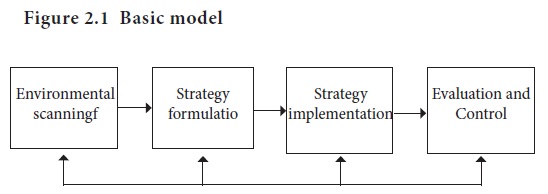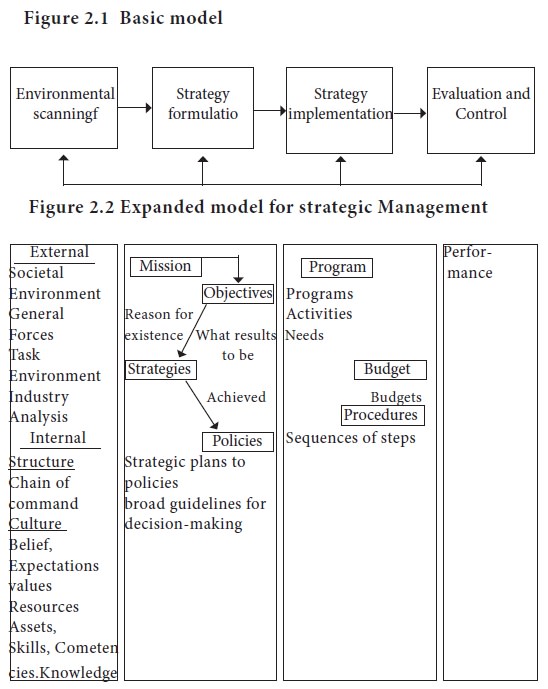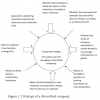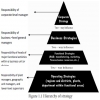Strategic Management - Concept Of Corporate Strategy
Process of Strategic Management - Strategic Management Process
Posted On :

Strategic management consists of four basic elements.
Process
of Strategic Management
Strategic management consists of four basic elements.
1. Environmental scanning
2. Strategy formulation
3. Strategy implementation
4. Evaluation and control
Figure 2. 1 shows simply how these elements interact. Figure 2 .2 ex-pands each of these elements and serves as the model
Environmental Scanning is the monitoring, evaluating, and dis-seminating of information from the external and internal environments to key people within the corporation. Its purpose is to identity strategic factors – those external and internal elements that will determine the future of the corporation.
The external environment consists of variables (Opportunities and Threats) that are outside the organization and not typically within the short-run control of top management. These variables form the con-text within which the corporation exists.

The internal environment of a corporation consist of variables (Strengths and Weakness) that are within the organization itself and are not usually within the short run control of top management. These vari-ables form the context in which work is done. They include the corpora-tion’s structure, culture, and resources.
The simplest way to conduct environmental scanning is through SWOT analysis . SWOT is an acronym used to describe those particular Strengths, Weaknesses, Opportunities, and Threats that are strategic fac-tors for a specific company.
Strategy formulation is the development of long-range plans for the effective management of environmental opportunities and threats, in light of corporate strengths and weaknesses. It includes defining the corporate mission, specifying achievable objectives, developing strate-gies and setting policy guidelines.
Strategy Implementation is the process by which strategies and polices are put into action through the development of programs, budgets and procedures. This process might involve changes within the overall cul-ture, structure, and/or management system of the entire organization. Most of the times strategy implementation is carried out by middle and lower level managers with top management’s review. Some times refer-eed to as operational planning, strategy implementation often involves day-to-day decisions in resource allocation. It includes programs, budg-ets and procedures.
Evaluation and control is the process in which corporate activities and performance results are monitored so that actual performance can be compared with desired performance. Managers at all levels use the re-sulting information to take corrective action and resolve problems. Al-though evaluation and control is the final major element of strategic management, it also can pinpoint weaknesses in previously implemented strategic plans and thus stimulate the entire process to begin again.
Strategic management consists of four basic elements.
2. Strategy formulation
3. Strategy implementation
4. Evaluation and control
Figure 2. 1 shows simply how these elements interact. Figure 2 .2 ex-pands each of these elements and serves as the model
Environmental Scanning is the monitoring, evaluating, and dis-seminating of information from the external and internal environments to key people within the corporation. Its purpose is to identity strategic factors – those external and internal elements that will determine the future of the corporation.
The external environment consists of variables (Opportunities and Threats) that are outside the organization and not typically within the short-run control of top management. These variables form the con-text within which the corporation exists.

The internal environment of a corporation consist of variables (Strengths and Weakness) that are within the organization itself and are not usually within the short run control of top management. These vari-ables form the context in which work is done. They include the corpora-tion’s structure, culture, and resources.
The simplest way to conduct environmental scanning is through SWOT analysis . SWOT is an acronym used to describe those particular Strengths, Weaknesses, Opportunities, and Threats that are strategic fac-tors for a specific company.
Strategy formulation is the development of long-range plans for the effective management of environmental opportunities and threats, in light of corporate strengths and weaknesses. It includes defining the corporate mission, specifying achievable objectives, developing strate-gies and setting policy guidelines.
Strategy Implementation is the process by which strategies and polices are put into action through the development of programs, budgets and procedures. This process might involve changes within the overall cul-ture, structure, and/or management system of the entire organization. Most of the times strategy implementation is carried out by middle and lower level managers with top management’s review. Some times refer-eed to as operational planning, strategy implementation often involves day-to-day decisions in resource allocation. It includes programs, budg-ets and procedures.
Evaluation and control is the process in which corporate activities and performance results are monitored so that actual performance can be compared with desired performance. Managers at all levels use the re-sulting information to take corrective action and resolve problems. Al-though evaluation and control is the final major element of strategic management, it also can pinpoint weaknesses in previously implemented strategic plans and thus stimulate the entire process to begin again.
Tags : Strategic Management - Concept Of Corporate Strategy
Last 30 days 3310 views














